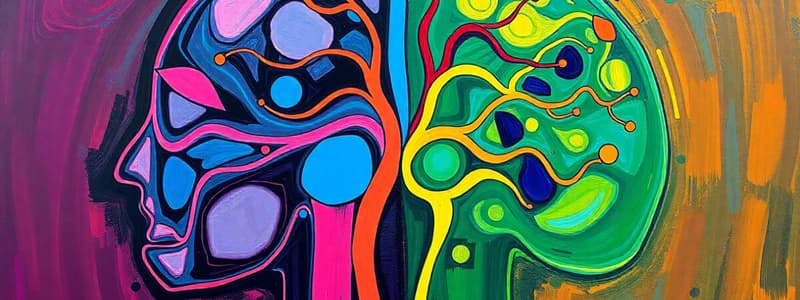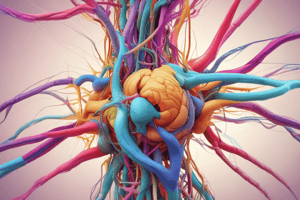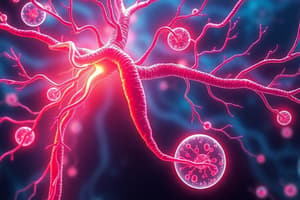Podcast
Questions and Answers
Which category is NOT typically associated with the sympathetic nervous system?
Which category is NOT typically associated with the sympathetic nervous system?
- Nora
- Beta
- Alpha
- M1 (correct)
What effect does beta activation generally have on blood vessels?
What effect does beta activation generally have on blood vessels?
- Increases blood pressure
- Increases heart rate
- Causes vasoconstriction
- Causes vasodilation (correct)
Which statement best describes the autonomic responses caused by the sympathetic nervous system?
Which statement best describes the autonomic responses caused by the sympathetic nervous system?
- Causes localized responses
- Primarily affects cardiac muscles
- Has a widespread effect (correct)
- Usually non-specific in effect
Which of the following statements best describes how the autonomic tonal status is characterized?
Which of the following statements best describes how the autonomic tonal status is characterized?
Which nerve is known for having widespread effects throughout the body?
Which nerve is known for having widespread effects throughout the body?
Which of the following is a characteristic unique to the parasympathetic nervous system?
Which of the following is a characteristic unique to the parasympathetic nervous system?
Which term is commonly used to describe the effect of the sympathetic nervous system on blood vessels?
Which term is commonly used to describe the effect of the sympathetic nervous system on blood vessels?
Which of the following muscles is most likely to be affected by sympathetic stimulation?
Which of the following muscles is most likely to be affected by sympathetic stimulation?
What is the primary neurotransmitter involved in the sympathetic nervous system?
What is the primary neurotransmitter involved in the sympathetic nervous system?
What is the primary function of the facial nerve?
What is the primary function of the facial nerve?
Which function is primarily regulated by the medulla oblongata?
Which function is primarily regulated by the medulla oblongata?
What role does the hypothalamus play in the autonomic nervous system?
What role does the hypothalamus play in the autonomic nervous system?
Which type of receptors are found at the synapses between preganglionic and post-ganglionic neurons in both sympathetic and parasympathetic nervous systems?
Which type of receptors are found at the synapses between preganglionic and post-ganglionic neurons in both sympathetic and parasympathetic nervous systems?
How does the sympathetic nervous system affect heart rate?
How does the sympathetic nervous system affect heart rate?
What aspect of the autonomic nervous system is considered involuntary?
What aspect of the autonomic nervous system is considered involuntary?
What metabolic function is primarily associated with β1 receptors?
What metabolic function is primarily associated with β1 receptors?
Which of the following correctly describes the composition of adrenaline and noradrenaline released by chromaffin cells?
Which of the following correctly describes the composition of adrenaline and noradrenaline released by chromaffin cells?
What physiological response is triggered by the mass sympathetic discharge?
What physiological response is triggered by the mass sympathetic discharge?
What is the primary role of β2 receptors in the body?
What is the primary role of β2 receptors in the body?
What type of tumor arises from chromaffin cells in the adrenal medulla?
What type of tumor arises from chromaffin cells in the adrenal medulla?
Which adrenergic action is NOT associated with epinephrine?
Which adrenergic action is NOT associated with epinephrine?
What is the main function of the adrenal medulla in the context of the sympathetic nervous system?
What is the main function of the adrenal medulla in the context of the sympathetic nervous system?
Which receptor type is primarily involved in metabolic effects related to heart functions?
Which receptor type is primarily involved in metabolic effects related to heart functions?
Which muscarinic receptor subtype is NOT mentioned in the context provided?
Which muscarinic receptor subtype is NOT mentioned in the context provided?
Which adrenergic receptor subtype is primarily associated with metabolic functions?
Which adrenergic receptor subtype is primarily associated with metabolic functions?
What response is associated with the activation of alpha adrenergic receptors?
What response is associated with the activation of alpha adrenergic receptors?
Which receptor subtype is responsible for bronchoconstriction and salivation?
Which receptor subtype is responsible for bronchoconstriction and salivation?
What effect do beta-2 adrenergic receptors primarily have on smooth muscle?
What effect do beta-2 adrenergic receptors primarily have on smooth muscle?
Which of the following is NOT a characteristic of muscarinic receptors?
Which of the following is NOT a characteristic of muscarinic receptors?
What is a key function of the M2 muscarinic receptor?
What is a key function of the M2 muscarinic receptor?
Which adrenergic receptor subtype is involved in both vasodilation and metabolic functions?
Which adrenergic receptor subtype is involved in both vasodilation and metabolic functions?
What is primarily controlled by the autonomic nervous system?
What is primarily controlled by the autonomic nervous system?
How quickly can the autonomic nervous system increase heart rate by twofold?
How quickly can the autonomic nervous system increase heart rate by twofold?
Which of the following organs is NOT predominantly affected by the autonomic nervous system?
Which of the following organs is NOT predominantly affected by the autonomic nervous system?
Which part of the central nervous system is NOT mentioned as controlling the autonomic nervous system?
Which part of the central nervous system is NOT mentioned as controlling the autonomic nervous system?
What is one of the primary functions regulated by the autonomic nervous system?
What is one of the primary functions regulated by the autonomic nervous system?
Which of the following best describes the actions of the autonomic nervous system?
Which of the following best describes the actions of the autonomic nervous system?
Which of the following systems is said to work closely with the autonomic nervous system?
Which of the following systems is said to work closely with the autonomic nervous system?
In what time frame can the autonomic nervous system double arterial blood pressure?
In what time frame can the autonomic nervous system double arterial blood pressure?
Flashcards are hidden until you start studying
Study Notes
Autonomic Nervous System Overview
- The autonomic nervous system (ANS) controls involuntary functions of visceral organs.
- Postganglionic axons synapse on visceral effectors: heart, bronchioles, vascular smooth muscle, gastrointestinal tract, bladder, genitalia.
- Regulates arterial pressure, bladder emptying, sweating, and body temperature.
- Responds rapidly; heart rate can double within 3-5 seconds.
ANS Control Centers
- Controlled by centers in spinal cord, brainstem, hypothalamus, limbic system, and frontal lobes.
- Integrates reflexes to manage functions like respiration, cardiac regulation, and vasomotor activity.
Sympathetic vs. Parasympathetic Systems
- Sympathetic system causes widespread effects ("fight or flight") using norepinephrine.
- Parasympathetic system causes localized responses, promoting relaxation and energy conservation.
- Both systems can be synergistic (e.g., reproductive functions).
Autonomic Efferent Pathways
- The facial nerve and vagus nerve are significant in autonomic pathways.
- Vagus nerve affects many organs, influencing broad physiological states.
Autonomic Tone
- Sympathetic tone increases heart rate; parasympathetic tone decreases heart rate.
- Both systems maintain a baseline activity level for smooth muscle, cardiac muscle, and intestines.
Cholinergic Receptors
- Nicotinic receptors found at the synapses between preganglionic and postganglionic neurons.
- Muscarinic receptors (M1, M2, M3, M4, M5) are located on effector cells influenced by cholinergic neurons.
- M1: Involved with gastrointestinal tract function.
- M2: Reduces heart rate (bradycardia).
- M3: Regulates smooth muscle contraction (e.g., bronchioles).
Adrenergic Receptors
- Recognize norepinephrine and epinephrine; classified as alpha (α) or beta (β) receptors.
- α receptors lead to vasoconstriction; β1 receptors involved in metabolic functions.
- β2 receptors promote relaxation of smooth muscles (e.g., bronchioles).
Function of the Adrenal Medulla
- Acts as a sympathetic ganglion releasing epinephrine (80%) and norepinephrine (20%).
- Enhances cardiovascular function and metabolic rate, especially during stress.
- Chromaffin cells are responsible for these secretions; tumors like pheochromocytoma increase catecholamine output.
Stress Response
- Mass sympathetic discharge triggers "fight or flight" responses during stress and excitement.
- Prepares the body for rapid action by mobilizing energy and resources.
Studying That Suits You
Use AI to generate personalized quizzes and flashcards to suit your learning preferences.




